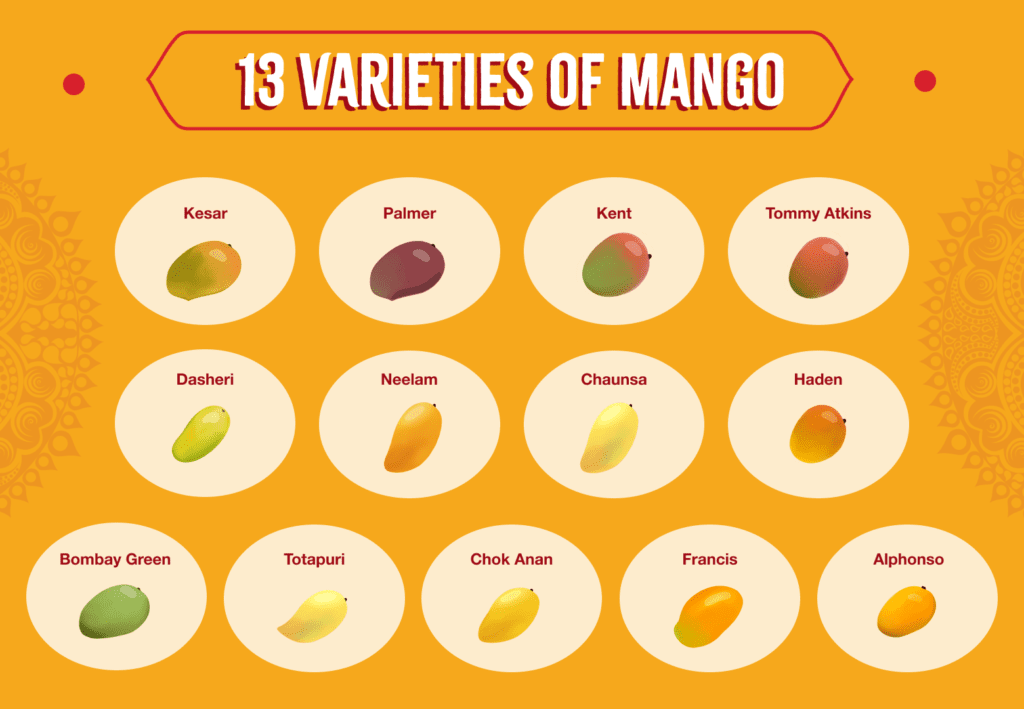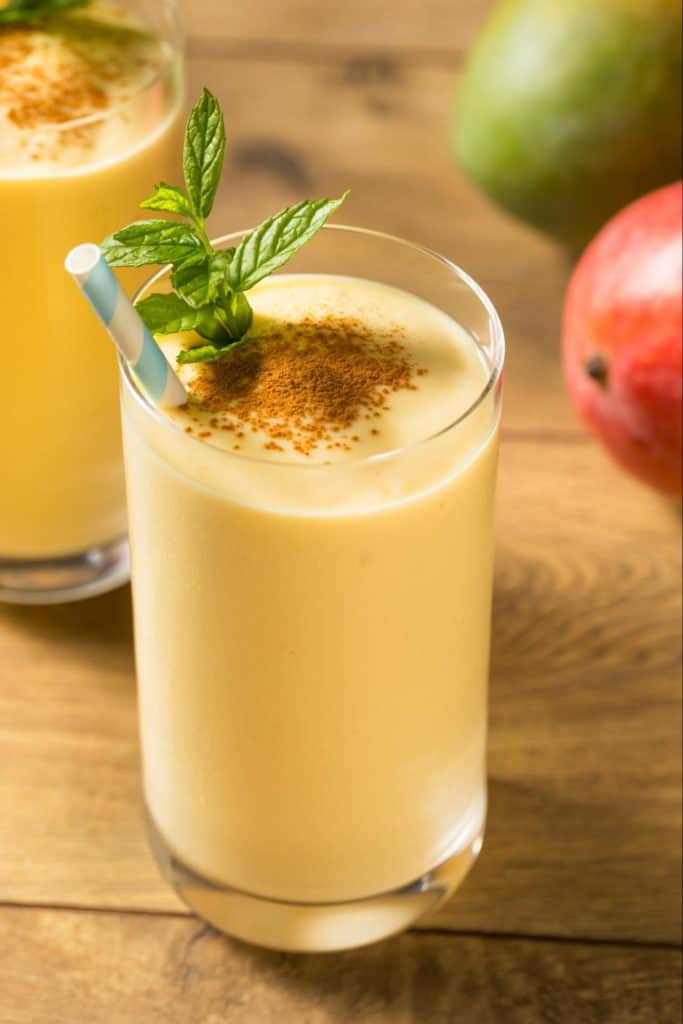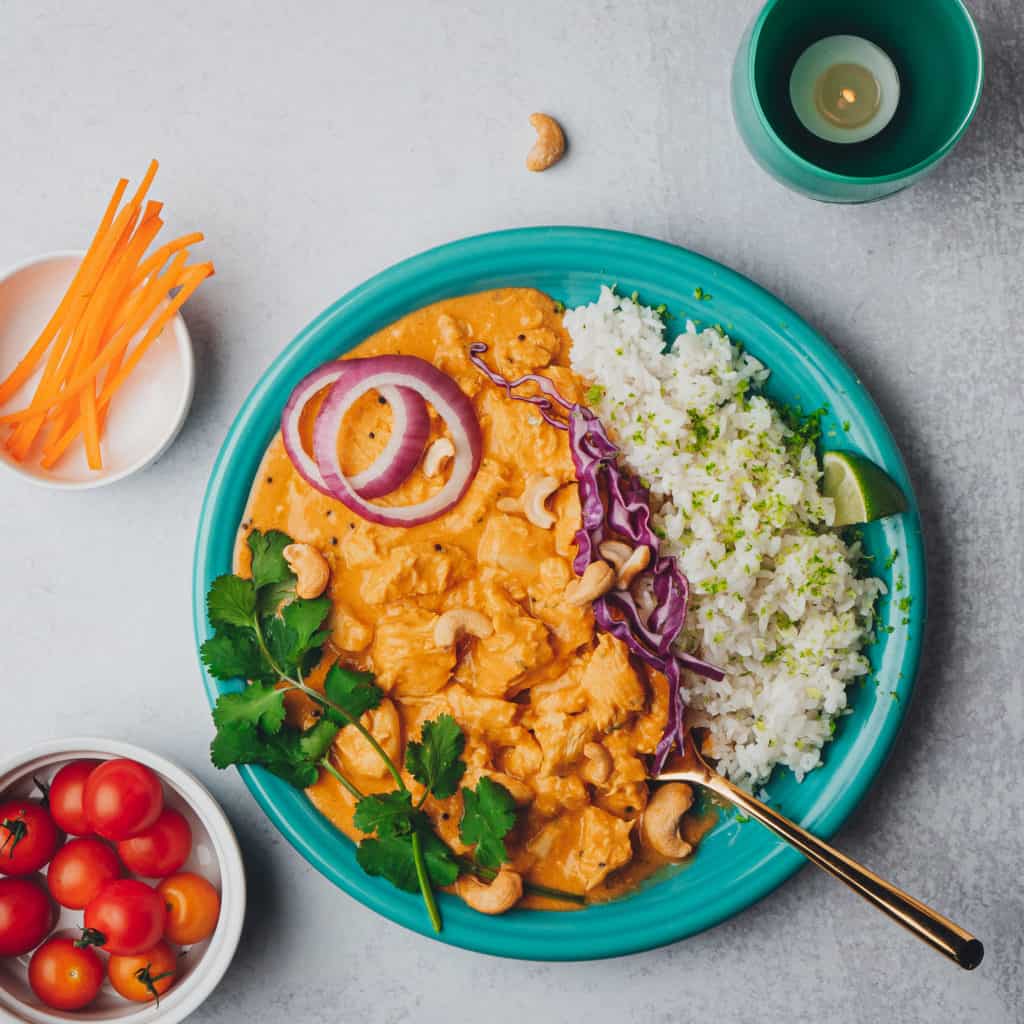The King Of Fruit: 13 Mouthwatering Mango Varieties

Summer — it’s the time of year for beach days, picnics in the park, and long-needed vacations.
But you know what else we look forward to during this sweltering season? Tropical, delicious, and sweet mangoes!
Juicy and perfectly suited for summer, mangoes earned the title of the “king of fruit” for a reason — they’re the national fruit of India and a delicious treat everyone looks forward to all year long.
Whether eaten on their own, blended into a tropical smoothie, or infused into a delicious dish, mangoes are mouthwatering and delicious however you like them. There are over 1000 varieties of mangoes, each with its unique taste, texture, and personality.
Let’s learn all about the different types of mangoes and discover why this sweet summer produce became known as “the king of fruits.”

1. Kesar
Bow down to the ‘Queen of Mangoes.’ Kesar mangoes are believed to have originated in Junagadh, a city in Gujarat, India.
Many citizens of the region often pluck and eat Kesar mangoes straight off the tree to taste their sweet, juicy flavors and soft, melt-in-your-mouth pulp. They feature in many juices, lassis, and delightful Indian desserts like mango shrikhand.
2. Palmer
Palmer mangoes are some of the largest grown worldwide, reaching up to 2 pounds in weight and filled with sweet mango juice. These goliaths hail from the tropical climates of Florida and Brazil and can be identified by their distinct oblong (oval) shape.
Palmer mangoes make a stunning addition to any summer smoothie, especially alongside strawberry, banana, and acai berries.
3. Kent
With peak availability centering around the winter months, Kent mangoes are the perfect option for those who need a summer splash, even as temperatures drop.
These cold-weather mangoes originate in Ecuador, Peru, and Mexico from Central and South America. Each bite of Kent delight with hints of sour contrasting their natural sweetness, often used in juicing and drying.

4. Tommy Atkins
If you’ve ever purchased a mango from the grocery store in the US or UK, you likely know the taste of the Tommy Atkins mango. It makes up nearly 80% of mangoes sold in both countries when you discount the growing regions of Florida, Hawaii, and California.
While mango aficionados might label Tommy Atkins as a middling mango when it comes to flavor, its long shelf life and tolerance to bruising and handling mean it’s a great introduction to all that this fruit has to offer.
5. Dasheri
Dasheri mangoes are cultivated in an extended growing season, with harvesting times anywhere from May to August. Once ripe, they display light yellow-green hues with peachy flesh.
Once plucked from the tree, Dasheri mangoes exhibit a fragrant, aromatic scent that hints at their natural juiciness. They’re one of the most beloved summer fruits in their natural homes of northern India, Nepal, and Pakistan.
6. Neelam
You can’t have a conversation about mangoes without mentioning the Neelam mango. Thought to be one of the delicacy mangoes grown in India, Neelam is famous for its slight acidity, especially when harvested just before properly ripening.
That bright, biting acidity amplifies the sweetness in every Neelam mango, giving them a more complex and layered flavor profile than other cultivars.
Some of the most coveted Neelam mangoes hail from the Indian state of Andhra Pradesh, with prime harvesting season centering around mid to late June.
7. Chaunsa
If you have an insatiable sweet tooth, your favorite mango might be Chaunsa. Filled with natural fruit sugars, Chaunsa isn’t a single variety but a small family of Indian mangoes, including white Chaunsa, honey Chaunsa, and sweet Chaunsa.
Chaunsa mangoes are known throughout India for their pale yellow skin and light red blush exterior. The flesh is soft, creamy, and exceptionally sweet.
8. Haden
Haden mangoes are perhaps the most popular in the United States, as most modern Floridian mangoes are siblings or cousins of the Haden mango.
Initially, Haden mangoes display a crimson skin that gradually yellows as it ripens. Thick fibers stretch throughout the fruit’s flesh to keep the texture more hearty and durable than many of the mangoes on this list.
So, if you want a bit of resistance and bite in your summer fruit, head to your local grocery or farmer’s market and pick up a bunch of Haden mangoes.

9. Bombay Green
Meet the lean, green mango machine.
Bombay Green mangoes originate from (you guessed it) Bombay and the surrounding area in central India. One unique quirk of Bombay Green is that it’s, well, green. This means it’s difficult to tell if it’s ripe simply by sight. Instead, you’ll have to grab the mango and squeeze the skin lightly.
If it’s hard as a rock, put it back. If it’s firm but slightly pliable, that’s your cue to pop that mango in your mouth or into a tall glass of refreshing lassi.
10. Totapuri
If you like a side of sour with your sweet, then Totapuri might be right up your alley.
These mangoes boast a uniquely acidic flavor profile, thick skin, and a pointed end. It’s found primarily in South India and western states like Maharashtra and Gujarat.
11. Chok Anan
While most mangoes exclusively ripen in the summers, Chok Anan trees also produce fruit in the winters! This makes it one of the most reliable mangoes in its home regions of Pakistan, Bangladesh, Thailand, and India.
12. Francis
Grown neither in Florida nor India, Francis mangoes are the first on this list to hail from the Caribbean nation of Haiti. They grow in a unique flat shape with a slight curve at the bottom. As they ripen, Francis mangoes morph from a light green hue to a deep orange sunset.
If you take a bite of a Francis mango, you’ll discover golden-yellow flesh with few natural fibers. In their homeland of Haiti, these fruits infuse a dose of bright sweetness into local dishes like Haitian mango chicken and spicy mango salsa.
13. Alphonso
Last but definitely not least on this list! If mango is the king of fruits, then Alphonso might be the king of mangoes.
Large in size and flavor, Alphonso displays bright yellow skin with creamy orange undertones. It’s one of the most popular and beloved mangoes due to its incredible flavor.
Regarding texture, Alphonso is one of the most tender mangoes on the market, making it a staple in fruit sorbets and smoothies due to its creamy golden-red flesh.

Fall In Love With Mangoes With Sukhi’s
We love mangoes. From their golden-yellow pulp to their sugary sweet juice, it’s easy to fall in love with the king of fruits a little more with each new bite.
That’s exactly why we gave mangoes the starring role in our mouthwatering mango chutney — the perfect accompaniment to curries, samosas, soft cheeses, or a simple bowl of yogurt.
Mangoes also feature beautifully in a supporting role in our Chicken Coconut Curry with Mango, serving as a sweet balance to the rich, creamy curry and mouth-watering spice.
Finally, mangoes are incredibly popular in the form of aam ka achar (mango pickle). This traditional Indian condiment comprises unripe mangoes (usually Kent or Haden), oil, and pickling spices.
As mango pickle ages, the ingredients ferment and take on new layers of delicious flavor, making it the perfect side dish to classic Indian entreés and flatbreads like chapati and aloo paratha.
3 responses to The King Of Fruit: 13 Mouthwatering Mango Varieties
very sigma i love mangoes
Very, very interesting article. I am amazed that there are 1,000 varies of mango, many of which I have never heard of.
In Hawaii, Haden, Kinney, Mapulehu, Rapoza, Kiri (sp?), plus others are grown here. I am unfamiliar with the ones from India, Mexico, and the Philippines.
Excellent article!!!
Interesting and informative love this fruit. thanks to oriental stores in Toronto